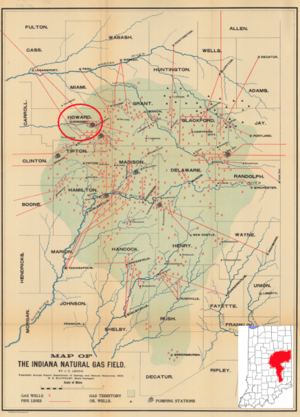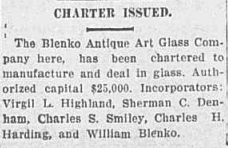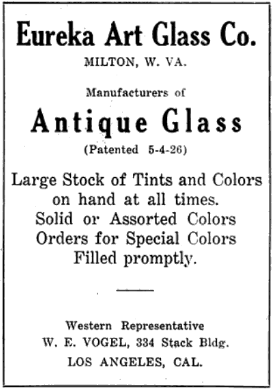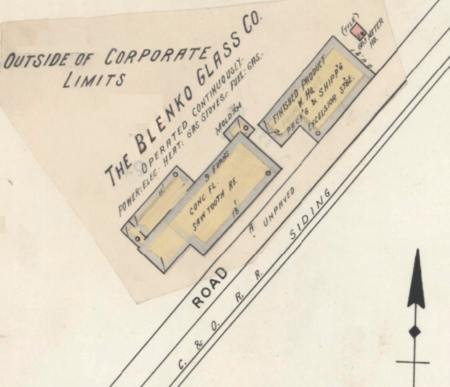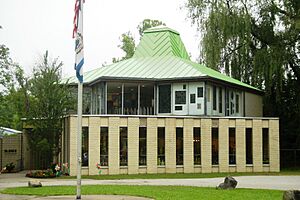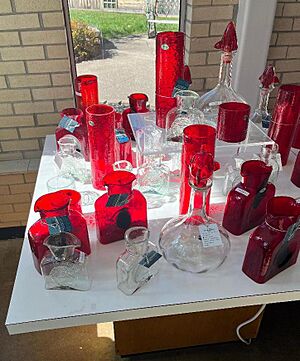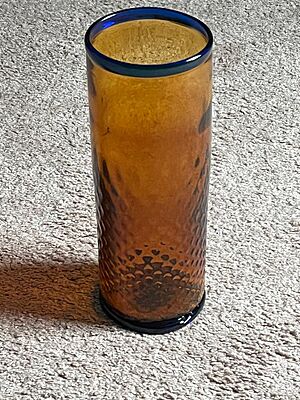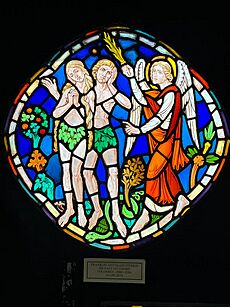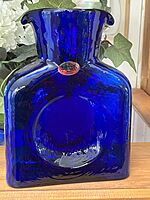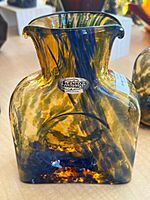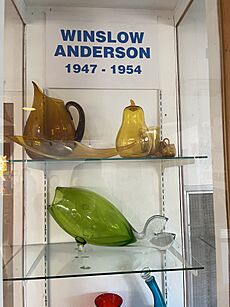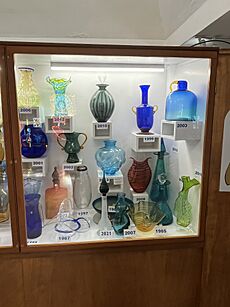Blenko Glass Company facts for kids
 |
|
|
Formerly
|
Eureka Art Glass |
|---|---|
| Private | |
| Industry | Glassware |
| Founded | 1922 |
| Founder | William J. Blenko |
| Headquarters | |
|
Key people
|
William J. Blenko, William H. Blenko Sr. |
| Products | hand-blown glassware |
| Owner | Blenko family |
|
Number of employees
|
160 (1965) |
Blenko Glass Company is a famous company that makes beautiful glass art. It started in 1922 as the Eureka Art Glass Company. In 1930, its name changed to Blenko Glass Company.
The company was founded by William J. Blenko, who came from England. He wanted to make glass in the United States. He tried to start glass factories in different states, but they didn't work out at first. His fourth factory, which opened in 1922 in Milton, West Virginia, finally became a big success. Today, members of the Blenko family still lead the company.
William Blenko was very good at making flat glass in many different colors. Other companies used his glass to create stained glass windows. Blenko used a special way to make glass called the cylinder method. Skilled glassblowers would blow glass into a cylinder shape inside a mold. Then, the glass cylinder was cut and flattened in an oven. All of Blenko's glass was made by hand, not by machines.
William Blenko's son, William H. Blenko, joined the company in 1923. When the Great Depression hit in 1929, people bought less window glass. So, William H. Blenko helped the company start making decorative glassware too. This was a great idea because the company could use its amazing skill in making many colors of glass.
Later, in the 1940s, Blenko started hiring designers. These designers created unique art glass pieces. Blenko still makes both glassware and flat glass today. Their glass is very popular with collectors.
Contents
Early Attempts to Make Glass
William John Blenko, who started Blenko Glass Company, was born in London in 1854. When he was just 10 years old, he began working in a bottle glass factory. There, he learned how to make glass. He also studied chemistry and learned to make flat glass sheets.
First Try in Indiana
Blenko first tried to open a glass factory in the United States in Kokomo, Indiana, in 1893. His factory was next to a railroad, and he brought his own equipment.
However, this business failed after about ten years. This happened for a few reasons:
- There was a tough economic time called the Panic of 1893.
- More glass was being imported from other countries.
- Many Americans thought that European glass was better than American-made glass.
It's even thought that Blenko sent his glass to England and then back to the U.S. to make it seem like it was European! After this business failed, Blenko and his family moved back to London in 1905. They returned to the U.S. about 14 months later and decided to live in Pennsylvania.
More Tries in Pennsylvania and West Virginia
Blenko's next attempt was in Point Marion, Pennsylvania. A map from 1909 shows a small "Blenko Glass Works" there. But Blenko left this factory to build a new one in Clarksburg, West Virginia, where fuel was cheaper. Construction started in 1911.
However, the Clarksburg factory, called Blenko Antique Art Glass Company, also failed in 1913. One big reason was a new law that lowered taxes on imported glass, making it harder for American companies to compete.
After his third factory failed, Blenko stayed in the United States. He continued to look for opportunities in glassmaking.
Starting the Eureka Art Glass Company
A New Beginning
In 1922, William Blenko bought land in Huntington, West Virginia. He planned to open a new factory to make colored antique glass. He named his new business Eureka Art Glass Company. By 1923, the company was making antiques and special glass items and had eight employees.
His son, William Henry Blenko Sr., joined the company that year. He was known for being "energetic and commercially astute" and helped the company become successful.
Instead of using new machines to make flat glass, Blenko continued to use his special way of making glass by hand. This process involved blowing glass into a cylinder inside a mold, cutting it, and then flattening it in an oven. This method made the glass look old and unique. William Blenko even got a patent for this process in 1926.
In 1924, William Blenko also found a way to make ruby-red glass that wouldn't change color when reheated. By 1926, Eureka Art Glass could make glass that looked just like the old European stained glass windows. For example, their glass was used for the stained glass windows of the Liverpool Cathedral in England in 1927. The business grew so much that they planned to build a larger factory in 1928.
Making Glassware for Homes
In 1929, the Great Depression began, which caused a big drop in demand for stained glass. To save the company, William Henry Blenko suggested they start making decorative glassware too. Since the Blenkos only knew how to make flat glass, they hired two brothers from Sweden, Louis Miller and Axel Muller, to teach their employees how to make glassware. These brothers had learned glassmaking in Sweden.
At first, a company called Carbone and Sons of Boston sold Eureka's glassware. This company usually sold high-quality Italian goods. Eureka's glassware had designs inspired by Italy and Scandinavia, and they used the company's ability to create hundreds of shades of colored glass.
Big Changes in the 1930s
In August 1930, Eureka Art Glass Company changed its name to Blenko Glass Company. By 1931, advertisements showed that "distinctive and different hand made" glassware could be bought at the Milton factory under the new name.
In 1932, Blenko glass was used for windows in the American Memorial chapel in France. Artists chose Blenko glass because of its bright, clear colors and unique texture. William J. Blenko passed away suddenly in November 1933 at age 79. His son, William Henry Blenko Sr., then became the company president.
In 1937, Blenko Glass Company was chosen to make all the glass reproductions for the Colonial Williamsburg restoration project. They used old glass pieces found at the site to make new glass that looked just like the originals. Blenko's old-style glassmaking process was perfect for this. In 1938, the company also started making a somewhat rectangular water bottle for its own line of glassware. This bottle is still made today!
After the War: New Designs and Growth
In 1947, Blenko hired its first full-time designer, Winslow Anderson. He helped the company become known for its modern art glass. Blenko's son, William H. Blenko Jr., also joined the company in 1946, becoming the third generation of the Blenko family to work there.
By 1950, the Blenko Glass factory had 115 employees. They made about 1,000 square feet of stained glass sheets and 3,000 pieces of glassware every day. The factory made about 280 types of glassware sold worldwide. Their flat glass came in about 1,000 different colors.
In 1955, Blenko Glass became the first American company to make a thick slab of glass called dalle de verre, which was previously made in France. Blenko's dalle de verre was used at the 1964 New York World's Fair in the Hall of Science. By 1965, Blenko had grown to 160 employees and continued to make glass by hand.
Visitor Center
William H. Blenko Sr. wanted a visitor center, and it opened in 1966. The building has a store on the first floor that sells glass pieces with small flaws at a lower price. Upstairs, there's a museum with displays of stained glass, the Colonial Williamsburg glass, and collectible pieces. It's also where factory tours begin.
William H. Blenko Sr. passed away in 1969. His son, William H. Blenko Jr., became president. By 1972, the Blenko Visitor Center and Museum had up to 2,000 visitors a day during tourist season. Blenko's stained glass windows were still very popular in 1974 because of their "vivid, clear colors."
Late 20th Century Glassmaking
In the 1980s and 1990s, Blenko started making various awards, like the Country Music Award. They also made glassware for President Ronald Reagan's dinners in 1981. The early 1980s were tough for glassmakers because natural gas prices were high and cheap imports were common.
The 1990s
By 1990, Blenko was one of the few glass factories still working in West Virginia. In 1995, about 30 percent of Blenko's business was flat glass, like hand-blown window panes. The other 70 percent was glassware, such as bottles, vases, and lamps. Blenko Glass Company had about 130 workers.
Blenko made glass globes for lights at the United States Capitol and helped with replacement windows for the White House. Blenko glassware was sold in big stores like Bloomingdale's and Nordstrom.
Richard D. Blenko, the fourth generation of the Blenko family, joined the company in 1976 and became president in 1996. He often promoted Blenko glassware by meeting customers in stores. He also helped with documentaries about the company. A PBS documentary called "Hearts of Glass: The Story of Blenko Handcraft" was released, telling the story of William J. Blenko's journey to make glass in the U.S. Many other documentaries about Blenko glass have been made since then.
Blenko in the 21st Century
Blenko's water bottles in many colors remained their most popular product. However, glassmaking in the United States started to decline in the 1990s. In 2003, an expert named Dean Six said that the problem for American glass factories wasn't just foreign competition. He believed people were "not buying glass at all" because plastic became common, and family meal habits changed after World War II.
The Great Recession and Recovery
The Great Recession, which started in late 2007, made things even harder for the American glass industry. In September 2008, Richard Blenko left the company, and Walter Blenko Jr. took over as president. By January 2009, Blenko was thinking about bankruptcy and stopped making glass for a short time.
However, orders increased, and Blenko was able to start making glass again. By August, the company employed about 50 people. Many products made by art glass companies like Blenko are "discretionary," meaning people buy them for fun, not because they need them. During a recession, people spend less on these items.
On May 12, 2011, Blenko Glass Company filed for Chapter 11 bankruptcy protection, but they still planned to keep making and selling glass. By August 2012, the company's situation improved because natural gas prices were lower and sales increased. A judge approved a plan for the company to reorganize. Blenko started focusing on selling to women aged 30 to 50 with middle to high incomes. They used more social media and videos to promote their products and relied more on internet sales instead of big department stores.
COVID and the Flatwoods Monster
Walter Blenko Jr., the company president, passed away in August 2019, just before the COVID pandemic began in 2020. John W. Blenko, who had joined the company in 2016, became the new president. The COVID-19 recession caused businesses to shut down to slow the spread of the disease. Blenko Glass closed for several months starting in March 2020, and all 48 employees were laid off.
In June, the company slowly started to reopen and make glassware again. Most of the workers were hired back by August. The company received a $250,000 loan from the government's Paycheck Protection Program, which helped them.
Blenko Glass survived and even did well, partly because of a new product: a figurine of West Virginia's mythical Flatwoods monster. This 16.5-inch tall figurine was colored clover green and ruby red. Only about 800 were made, and it was very popular with younger customers. The figurine sold for $129, which was much higher than most of their other products. Sales of the Flatwoods monster helped the company have its most profitable year in two decades. As of 2024, Blenko still makes glassware and has ten furnaces for glass production.
Other Collaborations
Since 2003, Blenko Glass has made the "Appy Awards" for the Appalachian Film Festival in Huntington, West Virginia. They create 13 awards for different film categories and a "Best in Festival" award.
Special Blenko Products and Designers
Blenko Glass Company has made many different products. Some of the most famous include:
- Their stained glass, used in cathedrals and churches worldwide.
- The 384 Water Bottle, which is often their best-selling item.
- Unique glassware created by their hired designers since 1947.
- Limited-edition collectible glassware that celebrates the state of West Virginia.
Stained and Flat Glass
Blenko's flat glass was used by other companies to create beautiful stained glass windows. After World War I, Blenko glass (then called Eureka) was used to help rebuild the Reims Cathedral in France. Blenko glass was also used at the Hall of Science at the 1939 New York World's Fair.
In its early years, Blenko stained glass was used in famous places like the Washington National Cathedral, Saint Patrick's Cathedral in New York, and the Duke University Chapel. By 1950, the Blenko factory made flat glass in about 1,000 different colors, which was shipped all over the United States and Canada.
In 1958, Blenko was the only company in the U.S. that still made hand-blown church window glass. Some of the glass for the United States Air Force Academy Chapel, finished in 1962, came from Blenko. Blenko stained glass was also used in other famous places like the Pro Football Hall of Fame and Grant's Tomb. The process for making this antique flat glass involved a glassblower blowing glass into a cylinder mold, cutting it, and then flattening it into a sheet. They could make it in about 1,100 shades.
In 1992, Blenko Glass was chosen to make replacement window panes for the White House. The White House needed windows that looked like the old, hand-blown ones already there. Blenko was the only American company that still used this old method. At that time, they could create over 1,300 colors of hand-blown flat glass.
The 384 Water Bottle
The Blenko 384 Water Bottle was first designed in 1938. The "384" means it was the fourth design made in 1938. This bottle has a narrow shape that was perfect for fitting in the door of the new "electric icebox" (what we now call a refrigerator). The bottle has two pouring spouts and a special indentation in the middle that makes it easy to hold. It's often called the "iconic" 384 Water Bottle and is the company's biggest seller.
Most of the molds Blenko uses are made of wood. But for the 384 Water Bottle, they use metal molds. This is because so many are made that a wooden mold would wear out every two days! The 384S Water Bottle, which has straight lines on the glass, was even featured in Martha Stewart Living magazine in 2013.
Glassware Designers
Blenko hired its first full-time designer, Winslow Anderson, in 1947. Anderson helped Blenko become known for its award-winning modern glassware. After Anderson left, Wayne Husted became the next designer. He made Blenko glassware even more modern and colorful, setting a trend for the company.
Joel Philip Myers took over as Blenko's design director in 1963. By this time, Blenko was known as one of the best art glass companies in the world. Myers was special because he was thought to be the only designer in the U.S. who blew his own glass. He designed about 40 new items each year, and thousands of copies of each design were made. Many collectors consider Myers to be Blenko's most famous designer.
Other designers for Blenko included John Nickerson, Don Shepherd, Hank Murta Adams, and Matthew Carter. Wayne Husted, an earlier designer, even worked with Blenko again in 2001. One of his designs after the September 11, 2001, was called Patriot, featuring red and blue glass.
Arlon Bayliss also designed for Blenko for nearly ten years. He created the special West Virginia Day glassware pieces. More recently, Emma Walters and Andrew Shaffer worked as designers. In 2020, designer Liz Pavlovic partnered with Blenko to create the limited edition Flatwoods monster glass piece. In 2024, Blenko worked with guest artist Don Pendleton, and the company's creative director, James Arnett, designed the 2024 West Virginia Day art glass piece.
West Virginia Day Glassware
Every year, Blenko Glass makes a special limited-edition piece of glassware to celebrate West Virginia Day. The number of pieces made is limited to one for each year West Virginia has been a state. This tradition started in 1980. For example, in 1980, West Virginia celebrated its 117th birthday, so Blenko made 117 commemorative bowls.
In 1995, Blenko's West Virginia Day design was a cobalt blue vase with clear handles. Only 132 pieces were made to honor the state's 132nd birthday. Customers would line up early to buy these special pieces.
Another example is the 2016 "Patience's Prize" vase. It was a pale green vase shaped like a fish jumping into water, celebrating West Virginia's outdoors and fishing. It was 14 inches tall and designed by Arlon Bayliss. Since West Virginia turned 153 years old on June 20, 2016, only 153 copies of "Patience's Prize" were made. They were sold only at the company's visitor center, and customers could buy only one.
See also
- List of museums in Huntington, West Virginia


